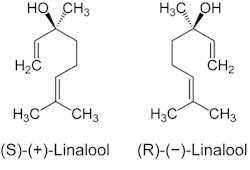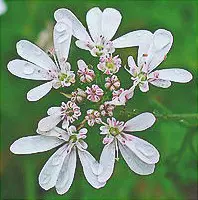Linalool is a natural active ingredient of plant origin used in veterinary medicine mainly in dogs and cats against some external parasites (lice, fleas, flies, etc). It is also used against agricultural and household pests.
Common name: LINALOOL
Other names: β-linalool, linalyl alcohol, linaloyl oxide, p-linalool, allo-ocimenol, and 3,7-dimethyl-1,6-octadien-3-ol.
Type: INSECTICIDE, REPELLENT
Some plants where it is found
- Aniba rosaedora (rosewood)
- Citrus spp (various citrus spp, mainly in the peels)
- Coriandrum sativum (coriander, cilantro, Chinese parsley)
- Cymbopogon martinii (palmarosa)
- Cinnamomum spp (various cynnamon species)
- Humulus lupulus (hop)
- Laurus nobilis (laurel)
- Lavandula officinalis (lavender)
- Myristica fragans (nutmeg)
- Ocimum basilicum (great basil)
- Origanum majorana (marjoram)
- Zingiber officinale (ginger)
- Etc.
CHEMICAL STRUCTURE

EFFICACY AGAINST PARASITES
Type of action: insecticide, repellent
Main veterinary parasites controlled: mosquitoes, fleas, etc.
Mechanism of action: Little is known about the molecular mechanism of action of linalool. It is thought to be neurotoxic and to act upon sensory cells increasing their activity. Such cells send wrong signals to the muscles causing tremors, convulsions and loss of coordination. It seems that it can also affect the central nervous system leading to hyperstimulation of motor neurons. All this can quickly cause paralysis of the affected insects. However, they can recover quite quickly unless linalool is administered together with PBO (piperonyl butoxide), a synergist that potentiates its efficacy. A certain repellent effect has also been reported for linalool.
A "crushing" efficacy should not be expected from natural products, comparable to that of modern synthetic insecticides, which are more potent and persistent than any natural compound. Simplifying, it can be said that natural active ingredients can be useful in places or seasons with low parasite challenge, but may be insufficient for controlling well established parasite populations (fleas, ticks, mites, etc.) in pets, let alone in livestock.
Efficacy against a specific parasite depends on the delivery form and on the dose administered. Check the labels of the products available in your country.
Click here for general information on features and characteristics of PARASITICIDES.
SAFETY
Oral LD50, rat, acute*: 2790 mg/kg
Dermal LD50, mouse, acute*: 5610 mg/kg
* These values refer to the active ingredient. Toxicity has to be determined for each formulation as well. Formulations are usually significantly less toxic than the active ingredients.
Linalool oxidized by air can cause allergic reactions, particularla in patients affected by eczema (dermatitis). Otherwise linalool is considered as rather safe for humans, domestic animals and the environment.
It must be remembered that the natural origin does not guarantee that such compounds are less toxic than the synthetic parasiticides. They are as "chemical" as the synthetic ones. Toxicity is a matter of dose!
General information on the safety of veterinary antiparasitics is available in specific articles in this site (click to visit):
- General safety of antiparasitics for domestic animals
- General safety of antiparasitics for humans
- General safety of antiparasitics for the environment
MARKETING & USAGE
Nowaday linalool is manufactured mainly by industrial chemical synthesis. Annual production was estimated to reach 12'000 tons in 2000.
Use in LIVESTOCK: Very scarce, mainly as ingredient in some essential oils
Use in HORSES: Very scarce, mainly as ingredient in some essential oils
Use in DOGS & CATS: Very scarce, mainly as ingredient in some essential oils
Use in human medicine: Yes, mainly in traditional medicine in some cultures.
Use in public/domestic hygiene: Yes, rather scarce, in some cockroach products
Use in agriculture: Yes, rather scarce
>PARASITE RESISTANCE
Reported in livestock & horses: NO
Reported in pets: NO
Reported in other uses: NO
Learn more about parasite resistance and how it develops.
ADDITIONAL INFORMATION

Linalool is a natural terpene alcohol produced by more than 200 plant species. It has two optic isomers S-linalool and R-linalool. Both have a characteristic odor and are used a lot in perfumes, cosmetics and other personal and home-care products (soaps, shampoos, detergents, air fresheners, etc). It is estimated that 60-80% of such products contain linalool. Linalool is also a component in certain wines (e.g. muscatel). Linalool is also used in industrial synthesis, e.g. a common downstream product of linalool is vitamin E.
S-linalool is also known as coriandrol. It has a coriander-type odor. It is one of the main constituents of coriander oil (Coriandrum sativum), palmarosa oil (Cymbopogon martinii ; up to 90% S-linalool), and sweet orange (Citrus x sinensis).
R-linalool is also known as licareol. It has a lavender-type odor. It is a main constituent of lavender oil (Lavandula officinalis), laurel oil (Laurus nobilis), and basil oil (Ocimum basilicum).
Use of linalool as an insecticide or insect repellent against crop, household or veterinary pests is irrelevant when compared with its industrial usage.
Linalool shares two features with many other natural insecticides: it is rather volatile and is unstable when exposed to sunlight. Consequently its effect in animals exposed to sunlight is very short: a few days or even only a few hours. This means that protection of the treated animals against re-infestations (residual effect) is virtually inexistent. This is particularly unfavorable for livestock that would need to be treated very frequently. However, for the same reason they do not leave chemical residues in food commodities (meat, milk, eggs, etc.), which is a benefit sought by organic producers.
Another disadvantage of many "natural products" extracted from plants is that quality (and thus efficacy) may vary, even if used following the label instructions, because producing extracts from heterogeneous plant materials is often less reliable than chemical synthesis.
Finally it must be said that in many countries registration of so-called "natural products" does not need a (serious) proof of efficacy, quality and safety as pesticides or veterinary medicines. This means that many such products have not been seriously tested in clinical trials in the field and consequently their efficacy and/or safety may not be granted. For such products, getting a market authorization does not need a substantial investment, which explains why there are so many brands in most countries.
- Click here to view the list of all technical summaries of natural antiparasitic active ingredients in this site.
- Click here to view the list of all technical summaries of antiparasitic active ingredients in this site.
- Click here to visit the article on medicinal plants with antiparasitic properties in this site.